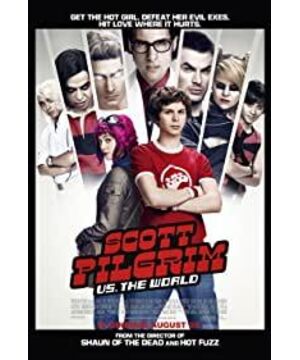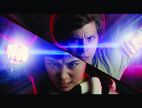He said, have you seen it? -I wasted nine months of my life on this.
This film is quite difficult to classify. Although the protagonist is a young man in his 20s, it seems to be called a "children's action romance" - PG.13 level. So it is difficult for a family man like me to have any identification with the protagonist.
First of all, the reality of the protagonist's poor psychological development and late maturity of emotional intelligence results in that although the theme of the film involves the emotional relationship between men and women, it fails to achieve a convincing growth process in the end.
If young viewers can learn anything from the film's emotional thread, it's this
-- take care of your girlfriend after she's done using it.
So after the story fails, everyone pays attention to the film format.
Director Edgar Wright (Shuan of the Dead, Hot Fuzz), known for his "post-modern" (verb here) mainstream cultural elements, this time plagiarizes Chinese kung fu and Japanese games; crafting the film with both art forms manifestations of violence. In this way, the story can move the love triangle of classic literature to the Street Fighter arena to solve it with fists and feet.
From the Universal Studio logo at the beginning, we can realize the postmodern pedigree of this film. Since then, Japanese arcade games and Chinese Kung Fu (many of which are copied from the "Kung Fu" style created by Stephen Chow) have appeared.
(Because of some "low-knowledge" netizens, I will explain it here on request.)
Most postmodern artists wake up the audience's critical awareness of pop culture by prompting mainstream art forms - such as the Daily Show, so that everyone can understand News shows have a lot of idiots, and Simpson's is about being as idiot-like as a homer when you get too caught up in American popular mass culture. Zhou Xingchi's seven-pin sesame official, the king of comedy, and kung fu all have sarcasm on Chinese officialdom and social ethos.
(End of explanation) Going back to "Scott Pilgrim", the exaggeration and representation of today's culture and youth genre films, such as North American middle school culture, cool vs. geek, battle of band competitions, etc. Ridiculous - but while we are watching the protagonist's jokes, the audience still expects that the director can make a powerful critique of today's youth culture - unfortunately, the director is only scratching the surface and has no really insightful views.
Then, the fantasy world created by combining kung fu and games is like a world of cats and mice. The characters have immortal bodies, and no matter how the physical experience is tossed, they are still as bright as before.
The goal of this fantasy world is to relax the audience, not to try to attract, inspire, and gain sympathy for the characters. So, in all fairness, I don't really care how the characters are going from start to finish - that's where this director doesn't do as well as he did in the first two films - whether it's Shaun or Sergeant Angel, I'm worried about his life or death .
——Then if this fantasy world is to please a new generation of moviegoers, then I'm not sure if they are still enthusiastic enough to support the film's many nostalgic game forms.
But even if the film failed at the box office in the end, I still feel that the directors and creators seem to have sincerely captured the confusion and lack of emotional intelligence of the "ruffian boy" generation on the emotional road.
Here, if this film is not only entertaining I hope there will be some awakening effect on the younger generation - then it may not be without it.
View more about Scott Pilgrim vs. the World reviews











